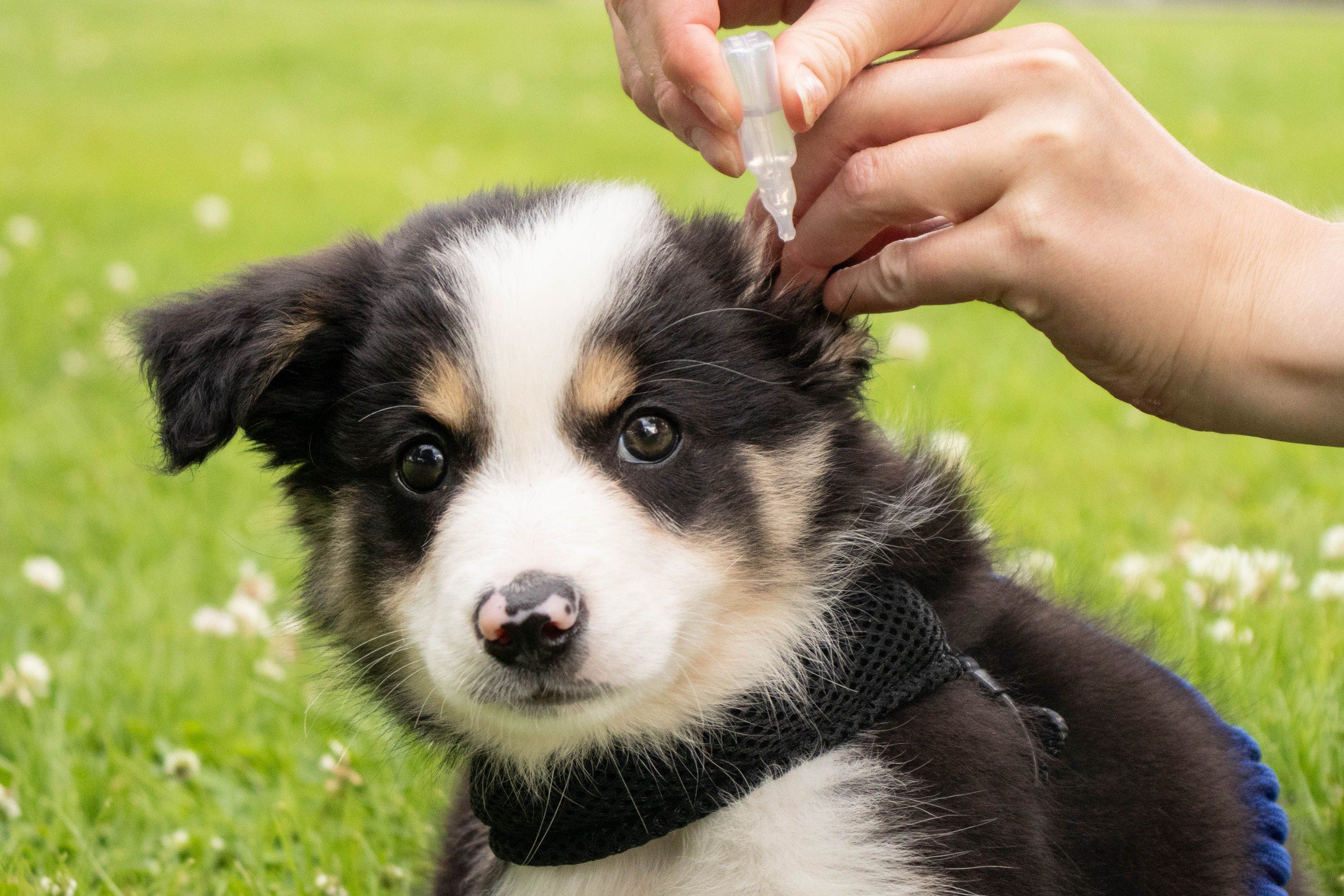There are some home remedies for ear mites in dogs that work well if you can't get to a veterinarian immediately. Ear mites are microscopic parasites that cause itchy ears and are contagious to other pets in the home. If one pet has ear mites, all of your furry friends will need treatment. For best results, your veterinarian can prescribe traditional medications that are proven effective. However, some items you have at home can also be safely used with your vet's approval. Here's how to use home remedies for ear mites in dogs.
Traditional Ear Mite Treatment
Before choosing a home remedy for your dog's ear mites, it's best to first consult with a veterinarian to get a diagnosis and check for an ear infection or other ear complications. In some cases, your vet may recommend a traditional medication over home remedies.
Treatment begins by cleaning the ears with a special cleansing solution to remove debris. Next, an insecticide will be used to kill the ear mites. Some medications are applied topically to the ears or skin while others are given orally. Certain flea and tick control products are also effective at treating ear mites, so you may simply need to switch the type of monthly preventive product you use.
Several commercial products are available for treating ear mites, so ask your veterinarian for a recommendation.

The Spruce / Charlotte Engelsen
Home Remedies for Ear Mites
Holistic veterinarians agree that commercial products work well, but dogs with ear mites may have other health challenges that need treatment. In some cases, it may be less stressful to shoo away the bugs with more natural treatments and let the vet handle the other issues. Of course, cleaning the ears with a cleaning solution is still the first step.
Antiseptic Tea Rinse
Green tea is a natural antiseptic that can be used to flush out all the ear mite debris—that crumbly brown/black stuff that clogs the dog’s ear canal. Steep a tablespoon of green tea leaves in a cup of hot water for three or four minutes and then strain it. Let it cool to room temperature before using it once a day for a month.
Oil Treatment
Oil can suffocate ear mites and help soothe sore ears; it may also float debris out of the ear canal. Holistic vets say it doesn’t matter what kind of oil you use, although some recommend corn, mineral, or olive oil.
For added benefit, crush a couple of garlic cloves in a cup of the oil and let it marinate overnight. Garlic naturally kills bacteria that might develop secondary to the mite infection. Remember to remove the garlic before using the oil to treat your dog’s ears, and don't let them eat the garlic or lick the oil.
You’ll need to treat the ears with the oil solution daily for at least a month.
Warning
Avoid using remedies that can make your dog's ears worse:
- Tea tree oil can be toxic and cause irritation.
- Baking soda is not effective and could clog up the ear canals.
- Hydrogen peroxide can irritate the ear canals.

The Spruce / Charlotte Engelsen
How to Use Home Remedies for Ear Mites in Dogs
Prescription treatments for ear mites may only need to be used short term. But if you're using a home remedy, you'll need to treat the ears daily for a month. That’s because eggs will continue to hatch for at least that time and can quickly re-infest the ears.
Your veterinarian may recommend ear medications that contain steroids to soothe inflammation or antibiotics to treat secondary bacterial infections. Be sure to use these as directed and ask your vet if it's safe to use home remedies as well.
Here's how to use the tea rinse and homemade oil for your dog's ear mites:
- Wear old clothes. You’re liable to get the tea or oil all over you when the dog shakes his head.
- Gather your supplies. You’ll need the tea rinse, oil, an applicator, a clean cloth, and treats. Use an eye dropper, squirt bottle, or a travel-size toiletry bottle. A clean, dry washcloth will help clean off excess medicine after the treatment. Treats should be given periodically throughout the process and again at the end.
- Put small dogs on a table or counter next to the supplies, but kneel beside larger pups. You can even do this in the bathtub. Get an extra set of hands to help keep wiggly pups from getting away.
- Pet your dog, rub his itchy ears, and speak in a matter-of-fact voice. Baby talk or “poor thing” types of language can cue that the experience will be unpleasant, and you want him to take the treatment in stride.
- Firmly grasp the ear flap with your left hand to expose the opening and keep the dog from shaking his head too soon.
- It works best to clean out all the goop before applying the ear medicine, otherwise, the waxy material might protect the ear mites. Use the tea solution first, and then follow up with the oily medication.
- Drip a few drops of the tea rinse into the ear. Don’t poke anything into the ears; just drip and let gravity move the liquid where it needs to go; otherwise, you risk hurting the eardrum and damaging hearing.
- Massage the base of the ear. It should sound a bit squishy as the liquid moves inside and loosens the debris. Your dog may like the way this feels, but be extra gentle if the ears seem painful.
- Let go of the ear and move away as he shakes his head and the debris flies out.
- Wipe the parts of the ear you can see with the cloth. You may need to do a second application to get all the goop.
- Use the oil in the same manner as steps 7 through 10.
- Repeat the tea rinse and oil application on the other ear.
Remember to offer a treat to your dog for putting up with the treatment!
Your dog will look a bit oily for the duration of treatment, so your dog may need a bath at the end of the month-long treatment. Contact your vet if your dog is not improving or is getting worse on home remedies.
- What do dog ear mites look like?
Ear mites are microscopic, invisible to the naked eye. What you'll see is a lot of debris in your dog's ears.
How do you know if your dog has ear mites?Your dog may shake its head and scratch its ears. And if you look inside those ears, you will notice a dirty, dark granular discharge.
How does a dog get ear mites?Ear mites are super common; dogs get them simply by being outdoors. They can also be passed from pet to pet (yes, from your cat as well).
If you suspect your pet is sick, call your vet immediately. For health-related questions, always consult your veterinarian, as they have examined your pet, know the pet's health history, and can make the best recommendations for your pet.








